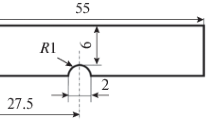Conclusions
-
1.
A generalized diagram of the effect of deformation temperature on the strength characteristics of Cr−Ni steels was constructed. The highest values of these properties are obtained with a deformation temperature near MS. The average strain hardening factor at MS is 2.7–5.0 kg/mm2 in terms of yield strength.
-
2.
Deformation at lower temperatures makes it possible to obtain higher ductility and toughness at the same values of the yield strength when σ0.2 < 80–140 kg/mm;2. When the yield strength is lower then high ductility and toughness are obtained by deformation at higher temperatures.
Similar content being viewed by others
Literature Cited
A. P. Gulyaev, "Martensitic transformation in steel", Metalloved. Term. Obrab. Met., No. 11, 5 (1959).
A. P. Gulyaev and I. V. Chernenko, "Effect of deformation at low temperatures on phase transformations and properties of austenitic steel 1Kh18N9T", Metalloved. Term. Obrab. Met., No. 5, 2 (1957).
Yu. V. Shakhnazarov, "Effect of plastic deformation, cold treatment, and aging on the strength characteristics of steel Kh18N9T", Metalloved. Term. Obrab. Met., No. 11, 58 (1966).
S. Floreen and J. Mihalisin, ASTM STP,369, 17 (1965).
D. McDowell and J. Mihalisin, Mat. Des. Eng.,53, No. 5, 10 (1961).
V. Krivobok and C. Mayne, Metalworking Production,99, 52 (1955).
D. T. Llewelin and D. D. Marrai, "Cold plastic deformation of stainless steels", in: High-Alloy Steels [Russian translation], A. G. Rakhshtadt (editor), Metallurgiya, Moscow (1969), p. 405.
N. N. Lyulicheva and N. V. Pisareva, "Heat treatment of cold-worked steel Kh18N9T", Metalloved. Term. Obrab. Met., No. 10, 41 (1963).
A. P. Gulyaev and V. M. Afonina, "Means of increasing the strength of stainless steel wire", Metalloved. Term. Obrab. Met., No. 11, 5 (1971).
V. B. Spiridonov, L. N. Kuz'minskaya, and Yu. P. Gordeev, "Strengthening Cr−Ni steels with unstable austenite", Metalloved. Term. Obrab. Met., No. 4, 2 (1973).
V. B. Spiridonov, Yu. P. Gordeev, and B. N. Podgorskii, "Strengthening of Cr−Ni steels with low-temperature deformation", Metalloved. Term. Obrab. Met., No. 5, 25 (1976).
V. B. Spiridonov, Yu. A. Skakov, and V. N. Iordanskii, "Microstructure of martensite in Cr−Ni steels", Metalloved. Term. Obrab. Met., No. 10, 49 (1964).
Additional information
Translated from Metallovedenie i Termicheskaya Obrabotka Metallov, No. 3, pp. 24–28, March, 1977.
Rights and permissions
About this article
Cite this article
Gordeev, Y.P., Spiridonov, V.B. Optimal deformation temperature for Cr−Ni steels to obtain high strength. Met Sci Heat Treat 19, 192–196 (1977). https://doi.org/10.1007/BF01166998
Issue Date:
DOI: https://doi.org/10.1007/BF01166998




